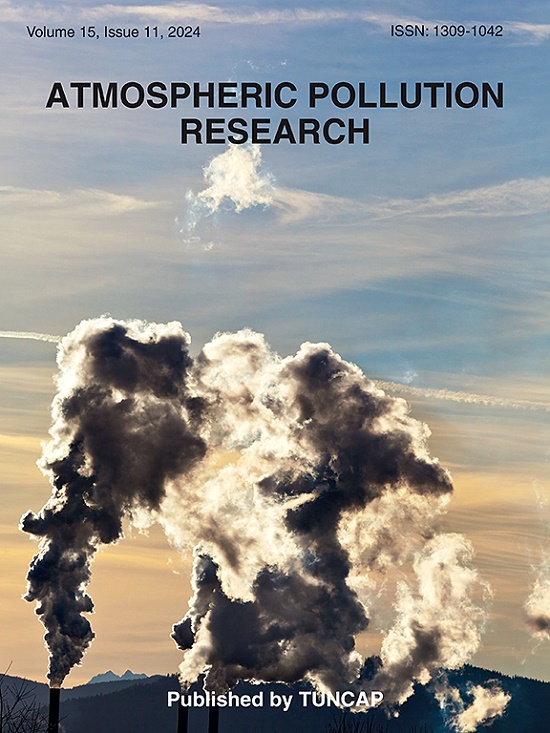Unprecedented impacts of meteorological and photolysis rates on ozone pollution in a coastal megacity of northern China
IF 3.9
3区 环境科学与生态学
Q2 ENVIRONMENTAL SCIENCES
引用次数: 0
Abstract
This study investigates the seasonal variations in O3 levels in Qingdao, a typical coastal city, and quantifies the effects of key photolysis rate constants (J[O1D] and J[NO2]), meteorological parameters (RH, TEMP, and SF), and pollutants (ΔCO, PM2.5, and NO2) on O3 levels across different seasons using machine learning. Additionally, the summer months, when photochemical reactions are most active, were analyzed in detail. The results indicate that the factors contributing to summer O3 levels in order of importance, were RH, ΔCO, SF, PM2.5, J[O1D], NO2, TEMP, WS, and J[NO2]. RH was the most significant factor, with high humidity levels (>75%) inhibiting O3 formation. ΔCO, representing regional transport, was the second most influential, suggesting that direct O3 transport and the delivery of high concentrations of precursors significantly promoted local O3 production and accumulation. While J[O1D] and J[NO2] had different roles in O3 promotion and depletion, J[O1D] had a greater impact overall. The temperature in the range of 26 °C–32 °C inhibits O3 production, When RH exceeded 90%, J[O1D] accelerates while other photolysis rate constants decline, further suppressing the production of O3. For comparison, multiple linear regression models were used to develop empirical equations for calculating hourly O3 concentrations across the four seasons. The results showed that these factors explained 50%, 64%, 61%, and 63% of the O3 sources in Qingdao for spring, summer, autumn, and winter, respectively. Sensitivity tests on factors influencing summer O3 concentrations found that MLR could not quantify their contributions to O3 levels.
气象和光解速率对中国北方沿海特大城市臭氧污染的空前影响
本文研究了典型沿海城市青岛臭氧水平的季节变化,并利用机器学习量化了关键光解速率常数(J[O1D]和J[NO2])、气象参数(RH、TEMP和SF)和污染物(ΔCO、PM2.5和NO2)对不同季节臭氧水平的影响。此外,对光化学反应最活跃的夏季进行了详细分析。结果表明,影响夏季O3水平的因子依次为RH、ΔCO、SF、PM2.5、J[O1D]、NO2、TEMP、WS和J[NO2]。RH是最重要的因素,高湿度水平(75%)抑制O3的形成。代表区域运输的ΔCO的影响力排在第二位,这表明直接的O3运输和高浓度前体的输送显著促进了当地O3的产生和积累。虽然J[O1D]和J[NO2]对O3的促进和消耗作用不同,但J[O1D]的总体影响更大。温度在26℃- 32℃范围内抑制O3的生成,当RH超过90%时,J[O1D]加速,其他光解速率常数下降,进一步抑制O3的生成。为了进行比较,采用多元线性回归模型建立了计算四季每小时O3浓度的经验方程。结果表明,这些因子分别解释了青岛市春、夏、秋、冬4个季节O3来源的50%、64%、61%和63%。对夏季O3浓度影响因素的敏感性试验发现,MLR不能量化它们对O3水平的贡献。
本文章由计算机程序翻译,如有差异,请以英文原文为准。
求助全文
约1分钟内获得全文
求助全文
来源期刊

Atmospheric Pollution Research
ENVIRONMENTAL SCIENCES-
CiteScore
8.30
自引率
6.70%
发文量
256
审稿时长
36 days
期刊介绍:
Atmospheric Pollution Research (APR) is an international journal designed for the publication of articles on air pollution. Papers should present novel experimental results, theory and modeling of air pollution on local, regional, or global scales. Areas covered are research on inorganic, organic, and persistent organic air pollutants, air quality monitoring, air quality management, atmospheric dispersion and transport, air-surface (soil, water, and vegetation) exchange of pollutants, dry and wet deposition, indoor air quality, exposure assessment, health effects, satellite measurements, natural emissions, atmospheric chemistry, greenhouse gases, and effects on climate change.
 求助内容:
求助内容: 应助结果提醒方式:
应助结果提醒方式:


